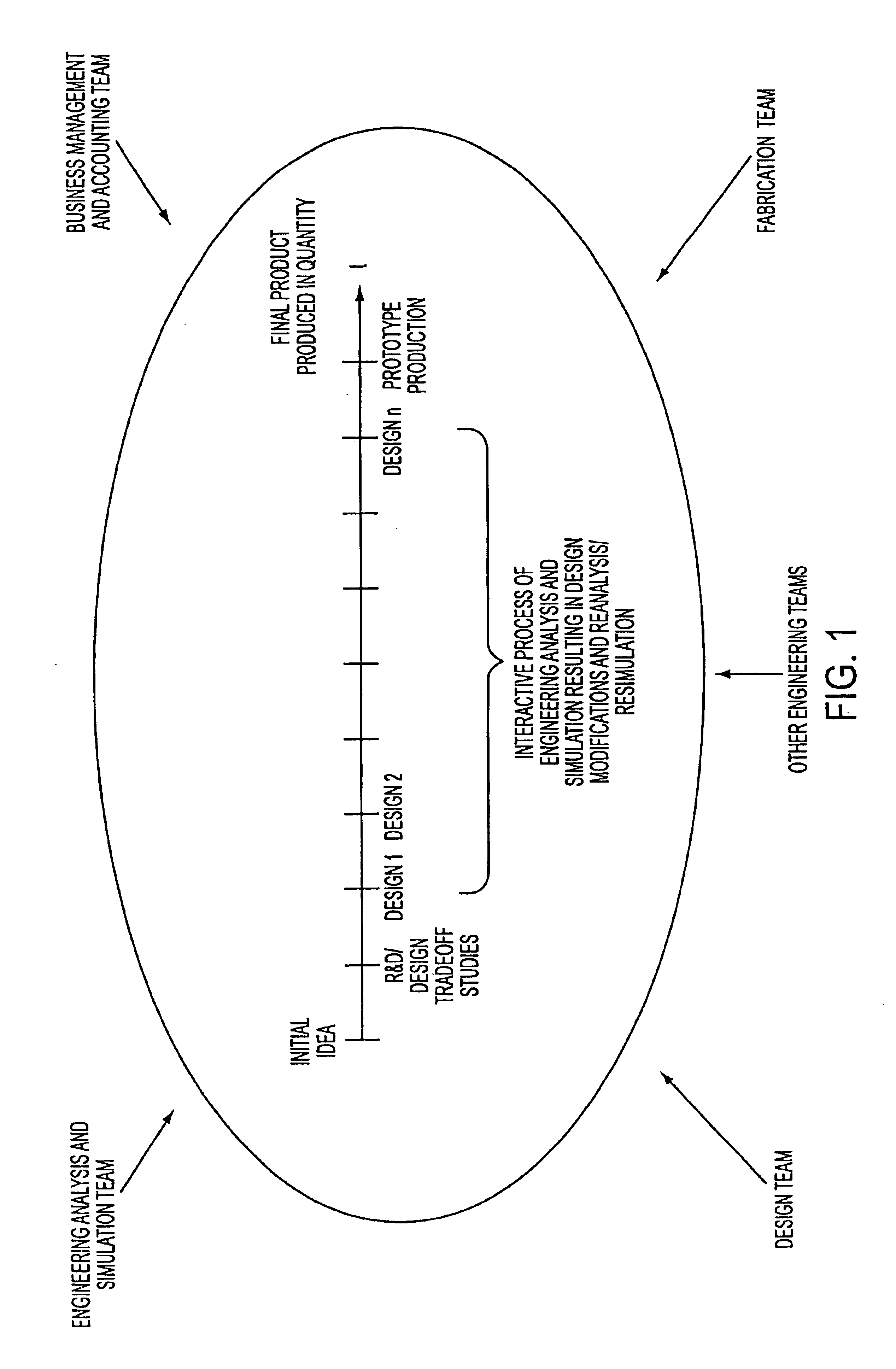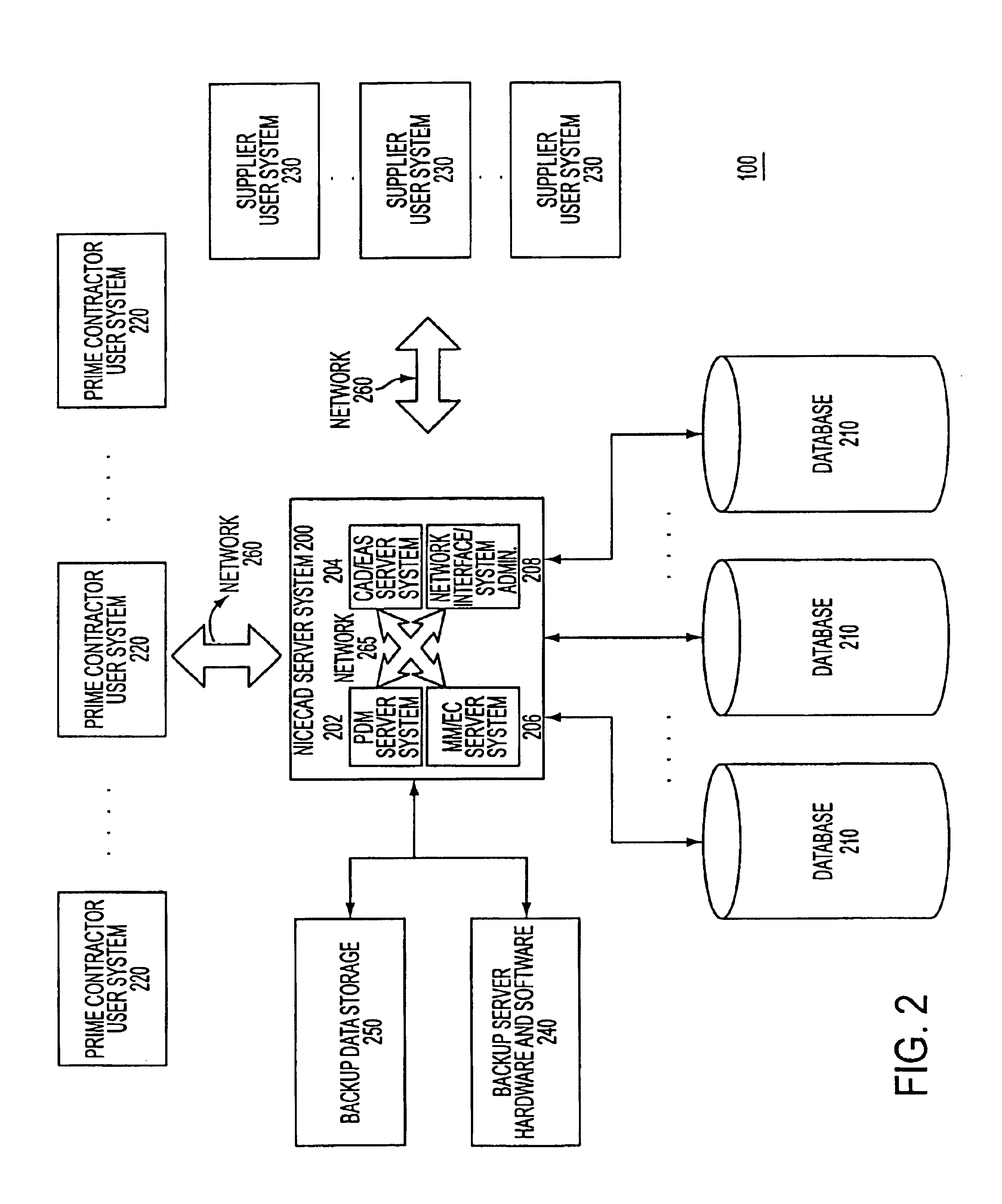[0023]It is another object of the present invention to provide an electronic marketplace and bidding system whereby a prime contractor can solicit proposals or bids in a virtual environment including the provision of specification and three-dimensional model data to prospective fabricators for consideration in developing their proposals.
[0026]Accordingly, what is disclosed is a network-based system
interfacing multiple user systems which interface through a central server to undertake the design development effort. A baseline design is created and maintained in a neutral or common format by the central server. A governing entity or prime contractor assigns access or
authorization data so that parts or the entirety of the three dimensional model and / or specification data is accessible by other team members in order to perform various analysis and simulations. An integrated
product data management (PDM) capability manages access to controlled data and maintains a
record of the various manifestations of the design. A current baseline design is maintained so that
engineering analysis and
simulation team members perform their analysis on the correct design. The system supports quasi-real-time
interactive audio, video and
graphics so that team members can discuss design issues in the virtual environment without having to cross geographic or format boundaries. The above-described capabilities are provided in a substantially
platform independent manner using a
graphical user interface (GUI) supported by standard software, such as a “browser,” which may further include
machine independent applications, such as
Java Applets™, or, for certain required tools, a semi-
machine-dependent application, to reduce the
processing burden on user stations and the need for specialized
client-side software. In an alternative embodiment of the invention, a so-called “custom browser” may be provided to user stations so that the interface with the central
server system is tailored to the present application. In yet another embodiment, certain
graphics-intensive applications may be provided by the central server as
client-side applications to be compiled and executed, such as applications coded in Open GL™ by
Silicon Graphics™. The so-called
common denominator in these embodiments is the goal of retaining the most calculation intensive tasks on the
server side of the overall system so as to reduce the need for specialized software and hardware capabilities at the user systems. Additionally, by receiving, converting, and maintaining part design models in a common, neutral format, the central
server system provides the important benefit of “data neutrality” for the participants in a concurrent engineering development project. In short, format boundaries are obviated. This is an important benefit, especially for small enterprises, which might otherwise be eliminated from participation in a project because their software resource do not support a format required by a prime contractor.
[0027]A second aspect of the system provides a
database of fabricators, a so-called “Global Manufacturer's Registry,” which can be searched by a designer or prime contractor to identify qualified fabricators. The database contains various information describing the fabricators, such as location, experience, machinery and process capabilities, certifications,
quality assurance / inspection standards, and so forth. Fabricators are incentivized to enroll in the registry because it provides an incidental benefit as a
capability management system they can use to manage and track their resources and capabilities. A prime contractor with a part design model representing a product can conduct a search to identify qualified fabricators based on design-specific and general criteria. The system includes producibility logic to analyze an uploaded part design in order to help identify qualified fabricators. The system allows prime contractors to provide feedback on performance which can be factored into a
quality assurance capability provided by the system. As with the NICECAD aspect of the integrated system, the GMR aspect provides data neutrality for users by supporting the upload and conversion of part design models from various format types into a standard neutral format. Therefore, a designer is not precluded from using the GMR system based on the fact that it uses a particular part design model format.
[0028]According to a third aspect of the system, an electronic bidding system is provided by an
Electronic Trading Community (ETC) to allow virtual discussions and negotiations to take place over the
networked system once a
pool of qualified fabricators is identified. A request for quote (RFQ) or request for proposal (RFP) with
design data is submitted to the system so that fabricators can submit proposals. The virtual
computer aided design (CAD) capability allows quasi-real-time discussions, including audio, video and graphics. The graphics capability allows a prime contractor and prospective fabricator to view the three-dimensional part design, including the execution of various manipulations, such as virtual rotations and translations, pan,
zoom and “fly throughs.” The stored part design model data may include links to associated specifications, standards and other design specific documents so that the bidding fabricator has a full representation of what it is bidding on. As with the NICECAD and GMR aspects of the integrated system, the ETC provides “data neutrality” so that format boundaries do not become impediments for either the soliciting prime contractor / designer or the bidding fabricator.
[0029]In general, the above capabilities are provided in a networked, virtual environment that reduces transaction costs and meets engineering challenges as it transcends geographic, business and format boundaries. One or more central servers maintain the part design model in neutral format, such as AP 214 STEP format, well known to those of skill in the art. Substantially platform user independent graphical interfaces, such as browser pages, and server-
client interactive applications, such as
Java Applets™ make the system substantially user-system independent. In some instances, instead of using
Java™ mini-applications or the like to run on a browser's so-called “
virtual machine,” certain graphics-intensive or computation-intensive applications may be compiled and executed at the user systems as semi-
machine-dependent applications amenable to operations using a computer system with a standard
operating system. Whether specialized applications are supported by miniapplications (e.g., such as those coded in Java™) provided through a browser or by server interface with a semi-machine-dependent application at a user
station (e.g., a server-provided application coded in Open GL™ readily executed on a
Unix™- or Windows™-based system), the goal is a substantial user
platform independent network interface with the
server system. Security is provided through
encryption and multiple firewalls at the server(s) so as to protect proprietary and sensitive data.
 Login to View More
Login to View More  Login to View More
Login to View More 


